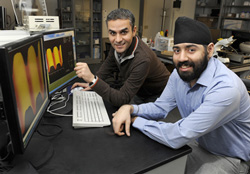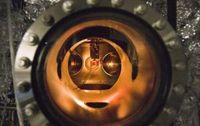
It's about trends.
Resource energy is going to get more expensive, and bringing it up to the surface will continue to cost lives. Solar energy is going to get cheaper, as technology changes. Eventually the two lines cross. Just because they haven't crossed yet does that mean we stop pushing toward solar breakthroughs, or give all our subsidies to coal, or stop buying solar systems?
A quick look at the news shows enormous progress. And it's important to note that progress is happening across the board — in gear being made today for shipment in the next year, in gear which may come out in 2012, and theoretically.
Breakthroughs are needed on efficiency, on cost, and on durability, as well as total capacity. New plants continue to come online. Current technology, based on the same construction techniques used to make silicon chips, has greater efficiency right now than thin films made of copper, indium, gallium selenide (CIGS), but CIGS efficiency is improving, and on a per-watt basis it should prove better than silicon soon.
This doesn't mean silicon is giving up. In fact, because it's a tested technology, silicon advances are coming onto the market faster than CIGS. Sharp has begun mass production of new cells with a back contact structure and improved alignment. It estimates production for next year alone at the equivalent of 200 megawatts.
Intevac, meanwhile, just bought Solar Implant Technologies with an eye toward bringing SIT's ion implant module to market in its LEAN SOLAR production system. Note that in both these cases we're looking at serious improvements to readily-manufactured systems and immediate production.
But don't just look at silicon and CIGS. Konarka produces a thin, flexible plastic with an efficiency rating of "only" 8.3%, but the flexibility and low cost of what it calls "power plastic" give it many market advantages.
Thin film polymers can become even more efficient. Iowa State researchers (above) think they can improve the efficiency of thin films by 20% with a very thin substrate that adds texture and can capture twice the light of flat cells. This is a manufacturing technique, which could make thin films as efficient as silicon or CIGS within a very short time.
One of the biggest problems for many solar technologies is they lose efficiency as the temperature rises. One of the biggest problem for solar analysts is we think only of current devices — silicon, CIGS, thin-film. Our view of solar technology is flat.

The theoretical efficiency of the process is 60%, which they hope to prove by replacing the gallium nitride semiconductor they had been using with gallium arsenide, which can take more heat.
What may be more important is that the Stanford effort challenges our idea of what solar energy looks like. We think of it as a panel, either flat or stretched (as with a plastic film). But it can also be a paint, or a point, a parabolic dish as with these Canadian models. And improvements are happening there as well.
Solar technology today is just about where silicon was 40 years ago. What it will look like in its final form is undetermined, but the excitement throughout the field is palpable.











Unfortunately we’ve been hearing about the impending doom due to loss of ‘non-renewable energies’ for decades. Ever heard of the Rome report? Created a big fuss – the whole world would be energy-less by the mid-seventies/eighties. Of course nothing of the sort happened. So yeah, keep dooming ‘n glooming. We believe ya…
Also, Dana states as a fact that the price of traditional fuels will go up and up due to extraction costs going up. That’s a clueless prediction. The same reasoning that he applies to solar energy technologies (increases efficiencies of creating) is also valid for traditional fuel creation/extraction. A little Googling goes a long way, Dana, and would help a more balanced point of view, instead of using wishful thinking as baseline.
The examples you give are interesting though, and in fact I’d welcome if solar power becomes cheaper than oil and gas, without having to pull an Obama on hardworking people (i.e. steal tax money to distort markets).
Unfortunately we’ve been hearing about the impending doom due to loss of ‘non-renewable energies’ for decades. Ever heard of the Rome report? Created a big fuss – the whole world would be energy-less by the mid-seventies/eighties. Of course nothing of the sort happened. So yeah, keep dooming ‘n glooming. We believe ya…
Also, Dana states as a fact that the price of traditional fuels will go up and up due to extraction costs going up. That’s a clueless prediction. The same reasoning that he applies to solar energy technologies (increases efficiencies of creating) is also valid for traditional fuel creation/extraction. A little Googling goes a long way, Dana, and would help a more balanced point of view, instead of using wishful thinking as baseline.
The examples you give are interesting though, and in fact I’d welcome if solar power becomes cheaper than oil and gas, without having to pull an Obama on hardworking people (i.e. steal tax money to distort markets).
Hi, thanks for this wonderful post. I’m really glad that solar breakthroughs are being made and discovered everyday. I myself is into Solar Energy, in fact, I have a small solar system in the house. Its really good for those who wants to go green, but are not yet fully ready for the whole big system. It can really help lower down the monthly bills, which I was aiming for.
Hi, thanks for this wonderful post. I’m really glad that solar breakthroughs are being made and discovered everyday. I myself is into Solar Energy, in fact, I have a small solar system in the house. Its really good for those who wants to go green, but are not yet fully ready for the whole big system. It can really help lower down the monthly bills, which I was aiming for.